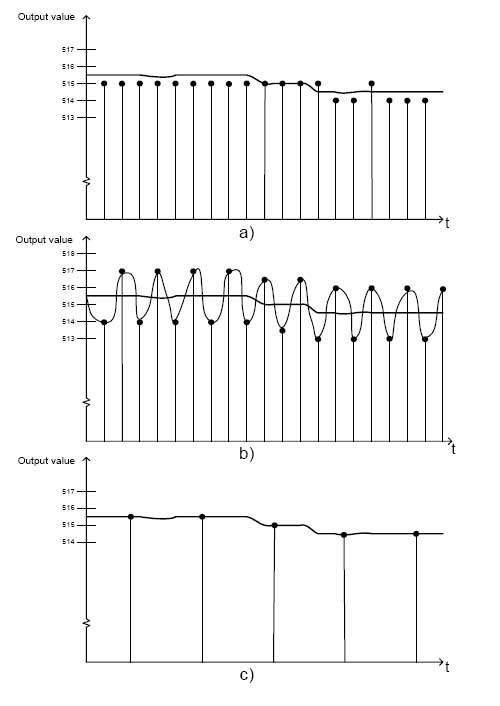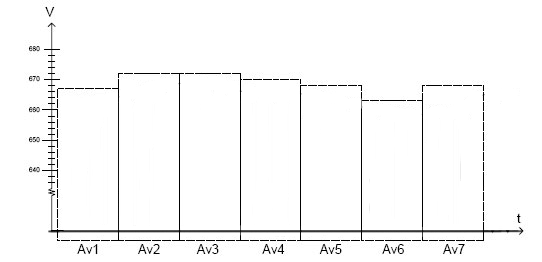Igoshin Roman
Faculty: Computer Sciences and Technologies Faculty
Specialty: Computer systems and networks
Deparment: Computer engineering
Theme of master's work: “ The research of algorithms of ADC’s resolution increase by oversampling signal ”
Scientific adviser: associate professor Krasnokytskiy Vladimir
 Abstract
Abstract
Introduction
Actuality of work:
Analog to digital conversion is used everywhere if required to process, keep or pass a signal in a digital form. As a rule, signals are digitized with minimally necessary frequency of sampling considering the economy, here noise of quantum is white, means his spectral closeness of power is evenly up-diffused in all bar. If to sample a signal with frequency of sampling, much more, than in the theorem of Kotelnikov-Shannon, and then then expose to digital filtration for suppression of spectrum out of frequency bar of initial signal, that relation signal/noise, it will be better, than while using all bar. Thus it’s possible to attain effective permission greater, than resolution of ADC.
Purpose:
The purpose of work is development and research of algorithm of oversampling signal which will allow to promote the resolution of ADC without the change of architecture.
Supposed scientific novelty:
A scientific and practical novelty consists of development of algorithm which will allow to promote exactness of measurings and quality of storable information due to increase the resolution of ADC.
The maintenance of work:
Oversampling and decimation
Theory, lying in basis of "Oversampling and decimation" is enough difficult, but using the algorithm simplifies a task. The technique requires a higher amount of samples. These additional samples can be got from oversampling the signal. For every additional bit of resolution, N, a signal must be oversamled four times (fig. 1). It is necessary for the receipt of the best presentation of analog input signal, because the greater amount of samples will give the best presentation of input signal, during decimation.
![]()
Figure 1. The condition of resolution increase
Noise
For correct work of algorithm, a signal component must not change while sampling. However other condition is that an input signal must change, during sampling. It can look as contradiction, but in this case change of signal to be produced only on a few lsb (lsb – least significant bit). Changes must look as noise component of signal. During oversampling signal, the presence of noise is nessesary for satisfaction of signal variation condition. The error of quantum in ADC is at least 0,5 lsb. Thus, amplitude of noise must exceed 0,5 lsb for switching the lsb. Noise amplitude 1-2 LSB guarantees that the process of selection will not be shut-down at a receipt the same values.
Criterias for noise, when using the decimation technique::
• The signal-component of interest should not vary significantly during a conversion.
• There should be some noise present in the signal.
• The amplitude of the noise should be at least 1 LSB.
The presence of noise during conversion is normal. Noise can be thermal, noise from CPU, switching I / O-ports, changes in a feed et al. This noise, in most cases, will be enough for correct algorithm’s work. However, on occasion, additional noise will be needed. Algorithm is refereed to as Dithering. The fig. 2a shows the problem of measuring signal with the value of tension, being between two steps of quantum.

Figure 2. ADC's «virtual resolution» increase.
Another reason to use this method is to increase the Signal to Noise Ratio. Enhancing the Effective Number Of Bits, ENOB, will spread the noise over a greater binary number. The noises influence on each binary digit will decrease. Doubling the sampling frequency will lower the in-band noise by 3dB, and increase the resolution of the measurement by 0.5 bits.
Averaging
The conventional meaning of averaging is adding m samples, and dividing the result by m. Refereed to as normal averaging. Averaging data from an ADC measurement is equivalent to a low-pass filter and has the advantage of attenuating signal fluctuation or noise, and flatten out peaks in the input signal. The Moving Average method is very often used to do this. It means taking m readings, place them in a cyclic queue and average the most recent m. This will give a slight time delay, because each sample is a representation of the last m samples. This can be done with or without overlapping windows. Figure 3 shows seven (Av1-Av7), independently Moving Average result without overlapping.

Figure 3. Moving Average principle.(GIF-animation 28,9 Kb 542 x 262 p. (8 cadr))
Conclusion
When ADC is sampling, he is quantum a signal in the discrete samples. Thus there are quantization errors. Normal decimation will be got only from fluctuation of signal, while decimation will increase the resolution of ACP. Additional standards and right shift on N, allows to increase the resolution of ADC and decrease the error of quantum. With of rapid ADC, low-cost memory, advantages of oversampling are economic effective and desirable!
Literature
- Многоуровневый метод передискретизации дискретных сигналов И. Г. Филиппенко [Электронный ресурс]
- Understanding Digital Signal Processing (2nd Edition) by Richard G. Lyons [Электронный ресурс]
- Л. Рабинер, Б. Гоулд Теория и применение цифровой обработки сигналов. М.: Мир, 1978. — 848 с. [Электронный ресурс]
- AVR 121: Enchancing ADC resolution by oversampling [Электронный ресурс]
